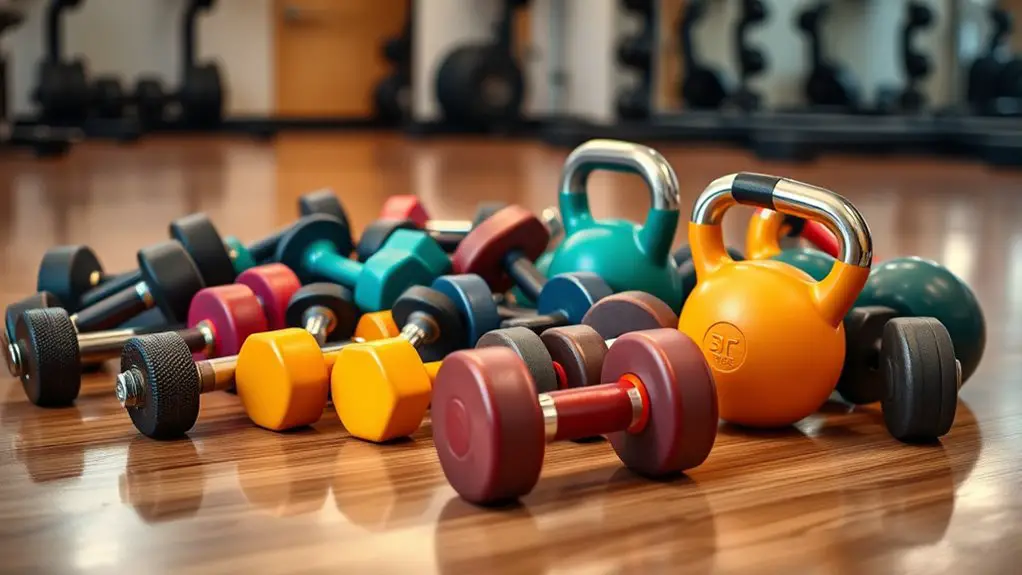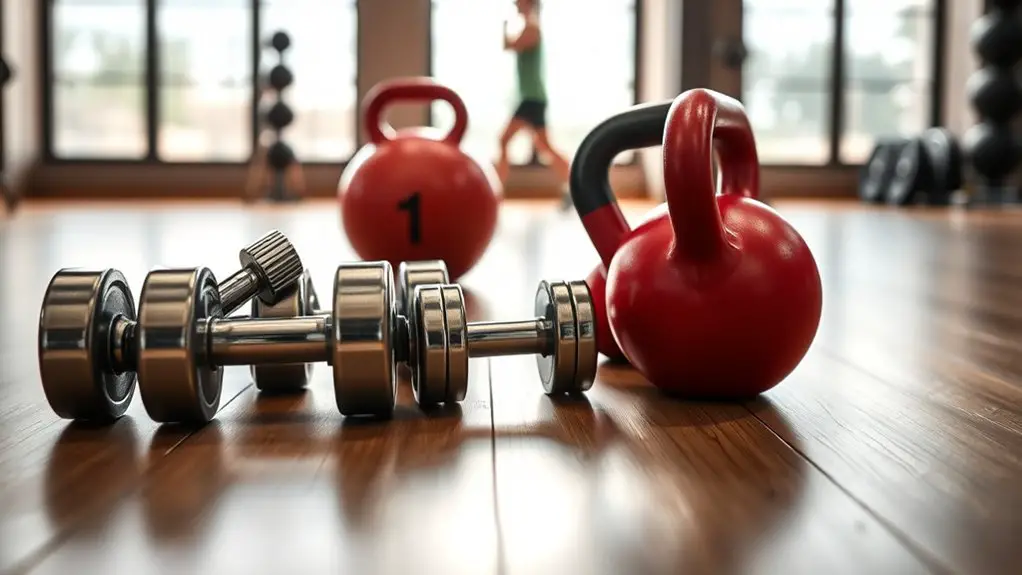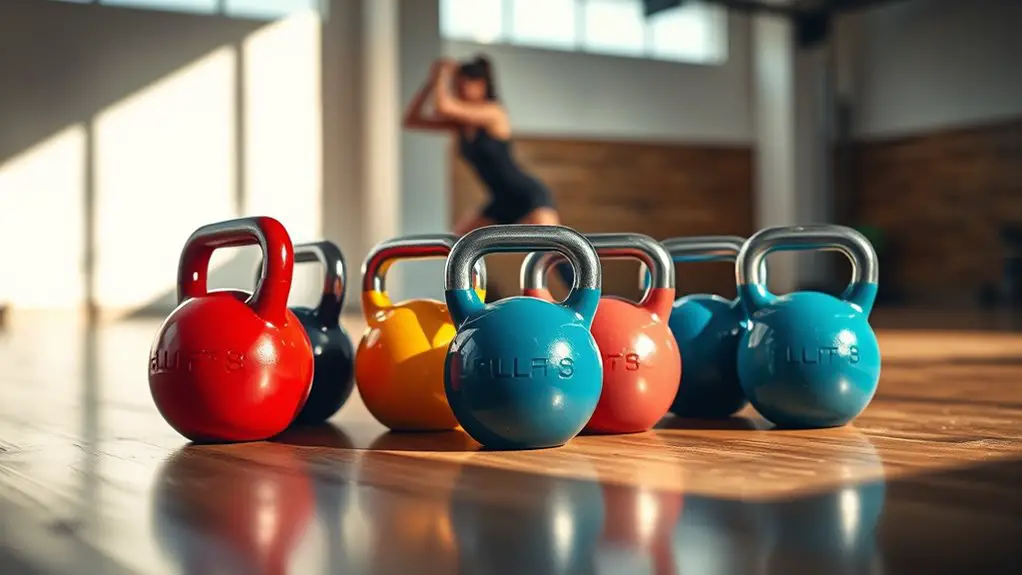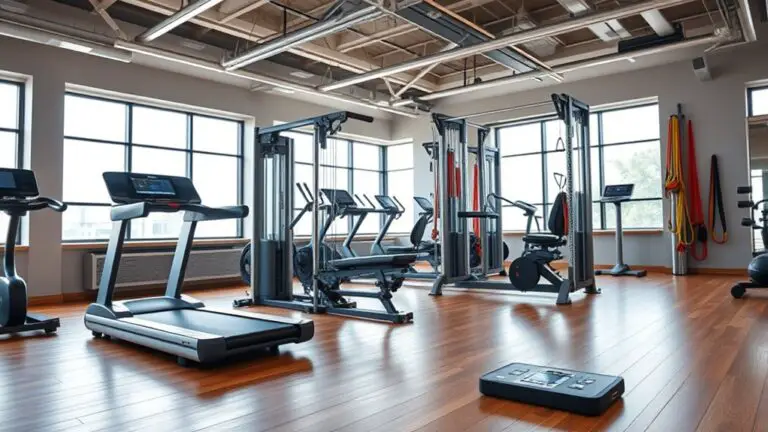Best Free Weights for Strength Training

When it comes to the best free weights for strength training, you’ll find dumbbells, barbells, kettlebells, and adjustable weights lead the pack. Dumbbells are versatile and great for all fitness levels. Barbells provide a solid foundation for compound lifts. Kettlebells offer dynamic movements for functional fitness. If you’re tight on space or budget, adjustable weights can be a game-changer. Each option has unique benefits that can enhance your workouts. Keep on exploring for tips on choosing the right ones for you!
Understanding Free Weights: Types and Benefits

When you’re diving into strength training, understanding free weights can really enhance your workouts. Free weights, such as dumbbells and kettlebells, allow for a range of training methods that promote functional strength and stability. Unlike machines, they require you to engage your core and stabilize your body, which can help prevent injuries when used correctly.
It’s essential to start with lighter weights to master your form before progressing. This approach not only builds strength but also guarantees you’re using safe techniques. Incorporating free weights into your routine can improve your balance, coordination, and overall muscular endurance. Plus, they’re versatile and can be used for various exercises targeting different muscle groups.
Always remember to listen to your body and prioritize safety. By choosing the right free weights and employing proper training methods, you’ll set yourself up for effective and injury-free workouts.
Dumbbells: Versatile Tools for Every Fitness Level
Dumbbells are some of the most versatile tools you can use for strength training, regardless of your fitness level. Understanding the benefits of dumbbell training, how to choose the right weight, and mastering essential exercises can help you get the most out of your workouts. Let’s explore how these simple weights can transform your fitness routine.
Benefits of Dumbbell Training
One of the standout features of dumbbell training is its unparalleled versatility, making it suitable for every fitness level. By incorporating dumbbells into your routine, you can achieve muscle growth while enhancing joint stability and balance improvement. This type of training promotes functional strength, helping you perform daily activities with ease. Plus, dumbbells offer an exciting workout variety, so you won’t get bored. Engaging different muscle groups not only boosts your metabolism but also encourages core engagement, which is essential for overall stability. Most importantly, when used correctly, dumbbells can aid in injury prevention by strengthening the muscles around your joints. So, whether you’re a beginner or advanced, dumbbell training is a safe and effective choice to elevate your fitness journey.
Choosing the Right Weight
Selecting the right weight for your dumbbells is essential for maximizing your strength training results. To guarantee safety and effectiveness, start with a personal assessment of your fitness level. If you’re new to strength training, opt for lighter weights that allow you to maintain proper form. As you gain confidence and strength, gradually increase your weight selection. Listen to your body—if you struggle to complete your sets or feel pain, it’s a sign you may need to adjust your weight. Remember, it’s better to start light and progress than to risk injury by lifting too heavy. By making thoughtful choices in weight selection, you’ll build strength safely and effectively, paving the way for long-term success.
Essential Dumbbell Exercises
After finding the right weight, it’s time to explore how to put those dumbbells to good use. Incorporating essential dumbbell exercises into your routine can enhance your strength and stability. Start with compound movements like the dumbbell squat and bench press, which engage multiple muscle groups, helping you build overall strength efficiently. Don’t forget to include dumbbell variations such as the single-arm row and overhead press to target specific muscles effectively. Always prioritize safety by maintaining proper form and controlling your movements to prevent injury. Gradually increase the weight as you progress, and listen to your body. With consistent practice, you’ll see improvements in your strength and confidence in no time!
Barbells: The Foundation of Strength Training
When it comes to strength training, barbells are essential for building muscle and power. You’ll want to explore different types of barbells and learn proper techniques to maximize your workouts. Let’s look at how these tools can elevate your training routine.
Types of Barbells
Barbells are essential tools for anyone serious about strength training, and understanding the different types can greatly enhance your workout routine. Here’s a quick overview of some common barbells you might consider:
| Type of Barbell | Description | Safety Features |
|---|---|---|
| Standard Barbells | Great for general strength training. | Typically lighter weight. |
| Olympic Barbells | Designed for heavy lifting and competition. | Higher weight capacity. |
| Specialty Bars | Includes hex bars, curl bars, and safety squat bars for targeted workouts. | Enhanced stability and support. |
Training bars and landmine attachments can also diversify your workouts while ensuring safety. Knowing the right barbell for your goals can make all the difference in your training journey.
Proper Barbell Techniques
Understanding proper barbell techniques is essential for maximizing your strength training results and minimizing the risk of injury. Start by guaranteeing your barbell grip is firm but relaxed; too tight can lead to strain. Position your hands evenly for balanced lifting. Next, focus on barbell alignment—keep the bar directly over your midfoot during lifts. This guarantees stability and helps maintain proper posture. As you lift, engage your core and keep your back straight. Always use a full range of motion, lowering the barbell safely and controlled. If you’re unsure about your form, consider working with a trainer. Prioritizing these techniques will not only enhance your performance but also keep you safe while you build strength.
Kettlebells: Dynamic Weights for Functional Fitness

Kettlebells offer a unique blend of versatility and adaptability, making them ideal for anyone looking to enhance their functional fitness. With their distinct shape, kettlebells allow for a variety of exercises that promote functional movement, which translates to improved performance in daily activities. One of the most effective exercises is the kettlebell swing; it builds strength while also engaging your core, glutes, and hamstrings.
When using kettlebells, focus on form to guarantee safety and maximize benefits. Start with lighter weights to master your technique before progressing to heavier options. Incorporating kettlebells into your routine not only boosts strength but also enhances coordination and balance, vital for overall fitness. Whether you’re a beginner or an experienced lifter, kettlebells can elevate your workouts, making them a fantastic choice for anyone aiming to achieve functional fitness safely and effectively.
Adjustable Weights: Space-Saving Solutions
If you’re short on space but still want an effective strength training solution, adjustable weights are the perfect answer. Adjustable dumbbells provide a versatile workout experience, allowing you to easily switch weights without needing multiple sets cluttering your space. With their compact storage, you can effortlessly tuck them away when not in use, making them ideal for smaller home gyms or apartments.
Safety is essential when lifting weights, and adjustable dumbbells are designed with secure locking mechanisms to guarantee the plates stay in place during your workouts. This minimizes the risk of injury and keeps your focus on perfecting your form. Plus, they cater to all fitness levels, enabling you to gradually increase resistance as you build strength.
Investing in adjustable weights not only saves space but also offers you a wide range of training options, making them a smart addition to your strength training arsenal.
Choosing the Right Free Weights for Your Goals

When it comes to selecting the right free weights for your fitness goals, it’s essential to take into account your specific needs and preferences. Start by identifying your objectives—whether you’re aiming for strength, endurance, or muscle tone. This will guide your weight selection strategies. For safety, choose weights that allow you to maintain proper form throughout your exercises.
If you’re new to strength training, it’s wise to begin with lighter weights, gradually increasing the load as you gain confidence and strength. For goal-oriented training, consider investing in adjustable weights, which can accommodate different exercises and progressions. Always remember to prioritize safety: warm up before lifting, and don’t hesitate to ask for guidance if you’re unsure about your weight choices. By aligning your weights with your goals and safety standards, you’ll create an effective and enjoyable strength training routine.
Frequently Asked Questions
How Often Should I Replace My Free Weights?
You should consider your free weights’ condition and safety when deciding how often to replace them. A good replacement schedule is every 3 to 5 years, but it depends on usage and maintenance. Regularly inspect your weights for signs of wear, such as rust or cracks. Proper weight maintenance can extend their lifespan, but if you notice any damage, it’s best to replace them sooner to guarantee safe workouts. Always prioritize safety!
Can I Use Free Weights if I’m a Beginner?
Imagine you’re planting a seed in a garden; with the right care, it’ll flourish. Yes, you can absolutely use free weights as a beginner! Start with light weights to build your foundation and guarantee safety. Beginner tips include focusing on form over heavy lifting and gradually increasing your weight selection as you gain confidence. Remember, it’s about progress, not perfection. Listen to your body, and enjoy the journey of strength training!
What’S the Best Way to Clean My Free Weights?
Cleaning your free weights is important for both hygiene and safety. Start with basic cleaning tips: use a damp cloth with mild soap for rubber or coated weights, and a microfiber cloth for metal ones. Avoid harsh chemicals that could damage the materials. Make sure to dry them thoroughly to prevent rust and slipping. Regularly cleaning not only keeps your workout area safe but also extends the life of your weights.
Are There Risks of Injury With Free Weights?
Imagine you’re sailing on a vast ocean; the winds of strength can be powerful, but without care, storms can arise. When using free weights, you must navigate the risks of injury. Prioritize injury prevention by focusing on proper form and weight selection. Start light, gradually increasing as you gain confidence. Just as a skilled sailor reads the waves, you’ll learn to listen to your body, steering clear of potential hazards on your fitness journey.
How Do I Store Free Weights Safely at Home?
When storing free weights at home, it’s essential to prioritize safety. Use weight storage racks to keep them organized and off the floor, reducing trip hazards. Make sure heavier weights are placed at the bottom, so they’re stable and easier to access. Always store weights in a dry area to prevent rust. Regularly check for any damage, and don’t hesitate to rearrange if you notice any safety concerns. Your safety matters!





